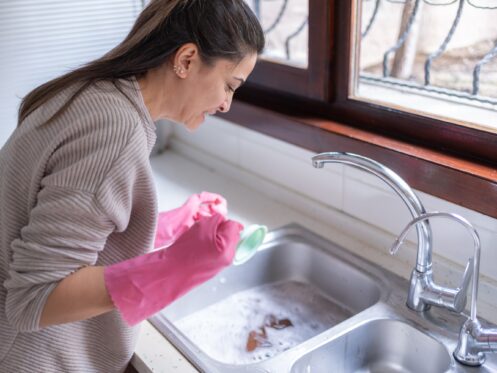Problems don’t stay hidden when something’s wrong with your sewer line. Gurgling drains, foul odors, and water backing up are signs that something deeper underground is happening. But figuring out exactly where the problem starts isn’t always easy from the surface. Sewer line issues can come from clogs, breaks, tree roots, or shifting soil, and unless you know what to look for, you’re left guessing. That’s where experienced local plumbers with the right tools make a real difference.
Slow Drains Point to Trouble
When water drains slower than usual, it’s easy to blame it on a clogged sink or a bit of hair in the shower. But if every drain in the house starts acting the same way, it’s often not about the individual fixtures. The real problem could be further down the line. A partial blockage in the sewer line builds pressure and may cause all the drains to slow down.
You might notice the kitchen sink taking longer to clear or the toilet struggling to flush completely. These early signs don’t always come with noise or smell, so people miss them. That’s why watching for patterns matters. When multiple drains seem affected, there’s usually a deeper issue worth checking out before things stop moving.
Gurgling Means Air Is Trapped
You might hear a gurgling sound after you flush the toilet or use the washing machine. That noise doesn’t happen randomly. It comes from air trapped in the sewer line that escapes through the nearest open pipe. That trapped air usually builds up behind a clog or a blockage. The pressure tries to move through the system and makes noise as it passes.
This doesn’t always happen in the same place. You might hear it in a bathtub after using the kitchen sink. That cross-connection makes things feel mysterious, but it helps point to a shared issue in the main line. When you hear gurgling often, it’s usually the sewer line trying to tell you something.
Smells Signal Waste Isn’t Moving
A clean plumbing system shouldn’t have a noticeable smell. If you’re picking up a musty or sewage-like odor indoors or outdoors, waste or gas isn’t venting like it should. A broken or sagging pipe can trap solids. That buildup starts to rot and release gas. The smell travels back through drains, especially if the traps have dried out or the system isn’t venting well.
Some people notice the smell after watering the yard or after a heavy rain. Ground moisture can press sewer gas up through hairline cracks or faulty joints. When the smell shows up inside, it usually means the issue is more serious than a slow drain or basic clog.
Backups Are a Clear Sign
Once wastewater starts coming back up through your drains, it’s clear the system isn’t doing its job. Backups might start in the shower or tub because they sit lower than sinks and are the first place overflow reaches. When a blockage in the main line gets worse, water can’t exit the house, so it reverses course. After running the washing machine, you might see dirty water pooling around a floor drain or rising in the bathtub. These events don’t always come with a warning.
Sometimes, everything seems fine until you suddenly notice water in the basement or a slow toilet becomes unusable. Cleaning up a backup is messy and stressful, but what matters more is figuring out what caused it. If the same thing keeps happening, it points to a bigger issue in the line that needs more than just a plunger.
Yard Clues Reveal Hidden Leaks
Not every sewer issue shows up inside your house. Sometimes, your yard gives the first clue. If the ground feels soft in one spot or you see a patch of grass growing faster than the rest, it could be a sign of a leak. A cracked or separated pipe allows wastewater to seep into the soil. That moisture feeds the surrounding area, leading to shifting ground, moldy smells, or even visible puddles in extreme cases.
Tree roots often follow this trail, growing into pipe joints and widening the damage. Root intrusion is one of the most common sewer problems and often goes unnoticed until the roots completely block the pipe. Watching your yard for small changes can help you catch problems before they become major repairs.
Cameras Help Spot the Problem
When symptoms appear, guessing isn’t the best strategy. That’s why plumbers use camera inspections. A high-definition waterproof camera travels through the sewer line, showing what’s happening in real time. The feed reveals blockages, cracks, sagging pipes, and roots. It also tells you the location of the issue, so there’s no need to dig up the whole yard.
A camera inspection doesn’t take long but gives detailed information that helps guide the repair. If you’ve been dealing with recurring issues or want to confirm what’s going on underground, a camera inspection gives clarity without disruption.
Heavy Rain Can Reveal Damage
After a heavy storm, your sewer line might act up in ways you didn’t expect. Water saturates the soil, and that pressure around your pipes can shift their position or widen small cracks. If your sewer line already has weak spots, a sudden surge of ground moisture can push debris into the line or collapse a barely holding section. You might notice backup from a floor drain or slow flushing toilets right after a storm passes.
These aren’t always caused by rainwater entering the sewer but by the system’s reduced ability to flow while the ground is soaked. If you spot changes in your drains that seem tied to bad weather, it’s worth taking a closer look. These signs are often your system’s way of showing that something underground isn’t holding up to pressure. Catching it now can prevent major damage during the next storm.
Repairs Last a Long Time
Once the source of the problem is clear, the next step is to repair it. Temporary fixes might get things moving again, but if the issue is structural, it needs to be handled properly. That could mean replacing a section of damaged pipe or using trenchless sewer repair technology to reline the existing one. These solutions are more reliable than snaking the line every few months.
If a pipe is cracked, you’ll continue to have issues until the damaged part is replaced. And if the slope of the line is wrong due to shifting soil, no cleaning will fix the flow. Professionals who handle the repair correct the root problem instead of patching symptoms. That keeps your system stable, which saves money and stress in the long run.
Fix Your Sewer Line Now
Pacific Plumbing & Rooter Inc in Eugene, OR helps homeowners track down hidden sewer problems before they cause serious damage. Our team offers an array of plumbing services, including pipe repair, drain cleaning, water heater installation, trenchless sewer repair, and well system maintenance. Give Pacific Plumbing & Rooter Inc a call, and let us take it from there.







